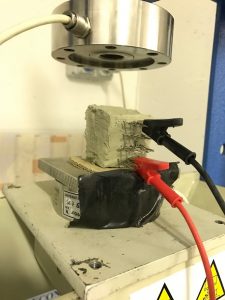CCEE associate professor joins in international collaboration to preserve Europe’s oldest infrastructure, increase safety for residents
Just because a building survives an earthquake doesn’t mean it’s safe.

“About 60 percent of Italian buildings, including those belonging to the historic heritage, are made of brick masonry,” said Filippo Ubertini, an associate professor of structural design at Italy’s University of Perugia. “Italian-built patrimony is highly exposed to seismic risk.”
In the weeks following a 6.2 magnitude earthquake that rocked Italy last August, the BBC reported nearly 300 people killed. Houses and buildings were razed, leaving another 4,000 homeless. It’s this seismic risk that is prompting Ubertini and Associate Professor Simon Laflamme to develop a smarter, cost-effective method for monitoring structural damage. It’s called SMART BRICK.
“We are re-thinking clay bricks, a construction material that has been around for thousands of years, by transforming it into a smart system, or a ‘smart brick,’” Laflamme, who specializes in structural health monitoring and adaptive systems at Iowa State University (ISU), said.
SMART BRICK is a brainchild built off of studies of smart concrete. Laflamme explained how smart concrete communicates state of strain and structural integrity through engineered electrical properties within the concrete itself. This monitoring can highlight damages that could threaten the structural integrity of the concrete. After studying smart concrete, Ubertini realized the concept might be transferred to clay bricks. He quickly decided that he and Laflamme should team up for the project. Ubertini would investigate ways to make smart bricks. Laflamme would find ways to implement the new technology.
“The main application is historic structures, in particular in Europe, where some of their clay bricks could be replaced by such smart brick during retrofit,” Laflamme explained.
The project, which began in 2016 and is predicted to last three years, is funded by the Italian Ministry of University and Research. With 60 percent of Italian buildings estimated to be more than 100 years old,* new monitoring technology can’t be developed fast enough.
“There is a strong need to develop automated systems that can real-time report on the safety conditions of a structure, so that temporary safety provision measurements can be timely installed where needed to prevent collapses during earthquake sequences and people can be evacuated from their houses if there is a safety concern,” Ubertini said.
Austin Downey, Laflamme’s student and an engineering post-doctoral researcher at ISU, traveled to Italy in July 2016. He was working with Ubertini at the time of the August earthquake.
“We went and looked for four hours,” Downey recounted post-earthquake observation of a historic bell tower. Even though the tower’s stress sensors had detected change, the team could find no evidence.
“We couldn’t find any damage on that bell tower,” Downey recalled. “Couldn’t find any damage, right? But the sensors picked it up. So we know that bell tower is a little more damaged than it was before the earthquake.”
Downey’s experience highlights a crucial flaw in traditional structural health monitoring techniques. Monitoring structural deterioration solely through visual observation is a defective method. Other systems are needed.
“The whole brick has multi-walled carbon nanotubes,” Downey explained the make-up of a smart brick. “That makes the whole brick itself a sensor.”
Throughout the fall semester, Downey gathered field data to find ways to quantify strain measurements from smart bricks. He admits balancing safety needs, historical preservation, and cost is tricky.
“Everything is historic in Italy. Everything,” Downey stressed. “… You don’t know whether it’s going to fall down in the next earthquake, or whether you should repair this building, or if leaving it is OK.”
So smart bricks could prove a better solution in the newest methods of structural health monitoring.
“Europe has numerous historic structures,” Laflamme said. “This project is directly aligned with the European Union’s objective to develop strategies for improving their resilience.”
The latest research from CCEE is at your fingertips via www.ccee.iastate.edu. Also check us out on Facebook, Twitter and LinkedIn (Iowa State University Civil, Construction and Environmental Engineering and ISUConE) for more news.
